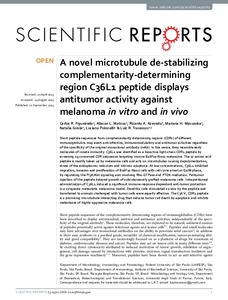| dc.contributor.author | Figueiredo CR | |
| dc.contributor.author | Azevedo RA | |
| dc.contributor.author | Girola N | |
| dc.contributor.author | Massaoka MH | |
| dc.contributor.author | Matsuo AL | |
| dc.contributor.author | Polonelli L | |
| dc.contributor.author | Travassos LR | |
| dc.date.accessioned | 2022-10-28T14:42:24Z | |
| dc.date.available | 2022-10-28T14:42:24Z | |
| dc.identifier.uri | https://www.utupub.fi/handle/10024/172888 | |
| dc.description.abstract | Short peptide sequences from complementarity-determining regions (CDRs) of different immunoglobulins may exert anti-infective, immunomodulatory and antitumor activities regardless of the specificity of the original monoclonal antibody (mAb). In this sense, they resemble early molecules of innate immunity. C36L1 was identified as a bioactive light-chain CDR1 peptide by screening 19 conserved CDR sequences targeting murine B16F10-Nex2 melanoma. The 17-amino acid peptide is readily taken up by melanoma cells and acts on microtubules causing depolymerization, stress of the endoplasmic reticulum and intrinsic apoptosis. At low concentrations, C36L1 inhibited migration, invasion and proliferation of B16F10-Nex2 cells with cell cycle arrest at G2/M phase, by regulating the PI3K/Akt signaling axis involving Rho-GTPase and PTEN mediation. Peritumor injection of the peptide delayed growth of subcutaneously grafted melanoma cells. Intraperitoneal administration of C36L1 induced a significant immune-response dependent anti-tumor protection in a syngeneic metastatic melanoma model. Dendritic cells stimulated ex-vivo by the peptide and transferred to animals challenged with tumor cells were equally effective. The C36 VL CDR1 peptide is a promising microtubule-interacting drug that induces tumor cell death by apoptosis and inhibits metastases of highly aggressive melanoma cells. | |
| dc.title | A novel microtubule de-stabilizing complementarity-determining region C36L1 peptide displays antitumor activity against melanoma in vitro and in vivo | |
| dc.identifier.url | https://www.nature.com/articles/srep14310 | |
| dc.identifier.urn | URN:NBN:fi-fe2021042827645 | |
| dc.relation.volume | 5 | |
| dc.contributor.organization | fi=MediCity|en=MediCity Research Laboratory| | |
| dc.contributor.organization-code | 2607003 | |
| dc.converis.publication-id | 41090960 | |
| dc.converis.url | https://research.utu.fi/converis/portal/Publication/41090960 | |
| dc.identifier.eissn | 2045-2322 | |
| dc.identifier.jour-issn | 2045-2322 | |
| dc.okm.affiliatedauthor | De Figueiredo, Rogerio | |
| dc.okm.discipline | 1182 Biochemistry, cell and molecular biology | en_GB |
| dc.okm.discipline | 1182 Biokemia, solu- ja molekyylibiologia | fi_FI |
| dc.okm.internationalcopublication | international co-publication | |
| dc.okm.internationality | International publication | |
| dc.okm.type | Journal article | |
| dc.relation.doi | 10.1038/srep14310 | |
| dc.relation.ispartofjournal | Scientific Reports | |
| dc.year.issued | 2015 | |
